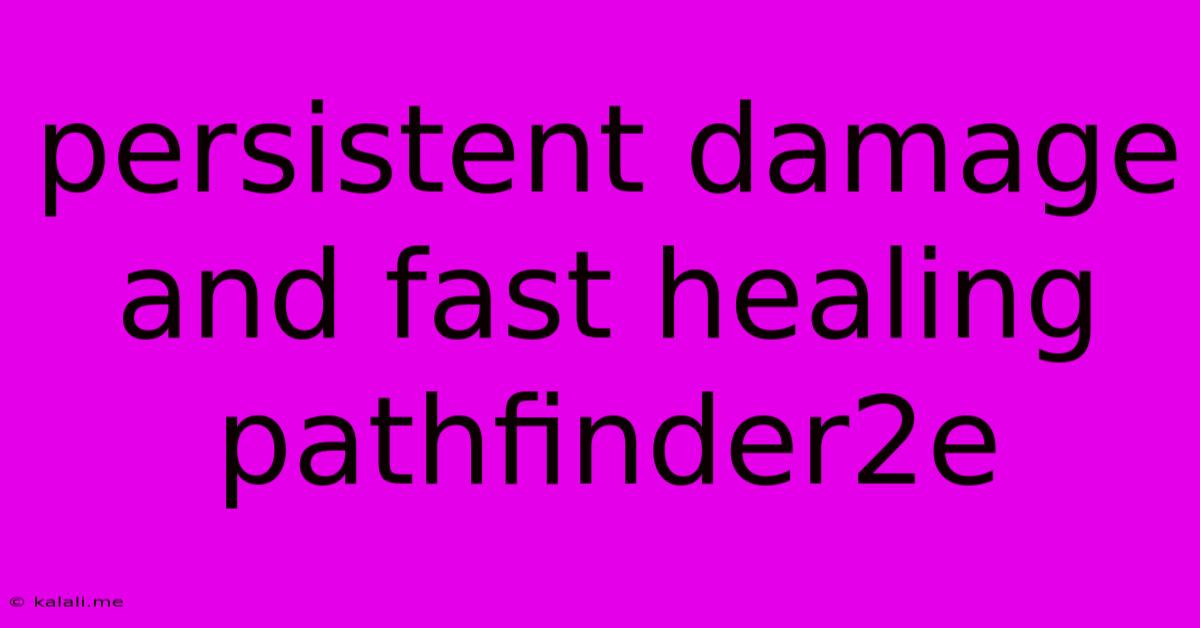Persistent Damage And Fast Healing Pathfinder2e
Kalali
May 23, 2025 · 3 min read

Table of Contents
Persistent Damage and Fast Healing in Pathfinder 2e: A Comprehensive Guide
Pathfinder Second Edition introduces a fascinating dynamic with its persistent damage and fast healing rules. Understanding how these mechanics interact is crucial for both players and Game Masters (GMs) to create engaging and balanced combat encounters. This article will delve into the intricacies of persistent damage and fast healing, offering strategies for both mitigating and leveraging these powerful elements.
Meta Description: Learn how persistent damage and fast healing work in Pathfinder 2e. This guide provides strategies for managing these mechanics in combat, offering insights for players and GMs to create balanced and engaging encounters.
Persistent damage, a debilitating condition inflicting ongoing harm, significantly impacts a creature's effectiveness. Fast healing, on the other hand, offers a counter-mechanism, allowing for rapid recovery from wounds. Mastering both is essential for success.
Understanding Persistent Damage
Persistent damage represents injuries that linger even after the initial attack. It's not simply damage that stacks; it's a condition that inflicts damage over time. This damage typically deals a small amount of damage each round, draining resources and potentially leading to incapacitation. Several sources can inflict persistent damage, including:
- Specific Spells and Abilities: Many spells and class abilities directly inflict persistent damage, often with additional negative effects.
- Weapon Properties: Certain weapons, particularly those with the corrosive, fiery, or freezing properties, inflict persistent damage of the corresponding type.
- Environmental Hazards: Exposure to dangerous environments, such as intense cold or poisonous fumes, can also inflict persistent damage.
The key characteristic of persistent damage is its cumulative effect. While a single instance might seem manageable, multiple sources or sustained exposure can quickly overwhelm a character.
The Mechanics of Fast Healing
Fast healing represents a creature's innate ability to quickly recover from wounds. Unlike healing spells or other restorative methods, fast healing works automatically at the end of each round. This recovery occurs before other effects, meaning it can help mitigate the effects of persistent damage. However, it's important to understand the limitations:
- Amount of Healing: The amount of fast healing varies greatly depending on the creature, ranging from a small amount to substantial recovery each round.
- Type of Damage: Fast healing typically only reduces hit points lost due to damage. It generally does not reduce persistent damage directly, but it can help a creature keep up with the steady drain.
- Circumstances: Certain conditions, such as being unconscious or severely weakened, might prevent or reduce fast healing.
The Interplay Between Persistent Damage and Fast Healing
The interaction between these two mechanics is crucial. A creature with significant fast healing can potentially negate the effects of minor persistent damage. However, high amounts of persistent damage can easily outpace even the most robust fast healing, leading to a dangerous situation.
This is where strategy becomes vital. Consider these points:
- Mitigation: Players should prioritize ways to reduce or remove persistent damage. This includes spells like cure, abilities that remove conditions, or strategically using items that can negate the effects.
- Balancing Fast Healing: Creatures with substantial fast healing are more resilient to persistent damage but still vulnerable to significant sources of ongoing harm.
- GM Considerations: GMs should carefully balance the amount and source of persistent damage in encounters, avoiding overwhelming players with insurmountable damage that negates player agency.
Strategies for Players and GMs
Players:
- Focus on Mitigation: Don't underestimate the value of spells and abilities that reduce or remove persistent damage.
- Utilize Defensive Actions: Employ tactics to avoid further damage and sources of persistent damage.
- Consider Item Usage: Utilize items that can negate or reduce ongoing damage.
GMs:
- Balance Encounters: Ensure that persistent damage sources are challenging but not impossible to overcome.
- Vary Damage Types: Diversify sources of persistent damage to prevent players from easily mitigating all threats.
- Consider Creature Design: Design creatures with appropriate fast healing to balance their vulnerability to persistent damage.
Understanding the complex interplay between persistent damage and fast healing is key to navigating combat effectively in Pathfinder 2e. By employing the strategies outlined above, players and GMs can create more dynamic, challenging, and ultimately more rewarding gameplay experiences.
Latest Posts
Latest Posts
-
Can You Use With The Name
May 23, 2025
-
Wil Latex Primer Last On Pressure Treated Plywood
May 23, 2025
-
How To Get To Kala E Bay
May 23, 2025
-
Ac Unit Blowing Cool Air Outside
May 23, 2025
-
Why Do Some Edges Have Light Blue Lines Blender
May 23, 2025
Related Post
Thank you for visiting our website which covers about Persistent Damage And Fast Healing Pathfinder2e . We hope the information provided has been useful to you. Feel free to contact us if you have any questions or need further assistance. See you next time and don't miss to bookmark.